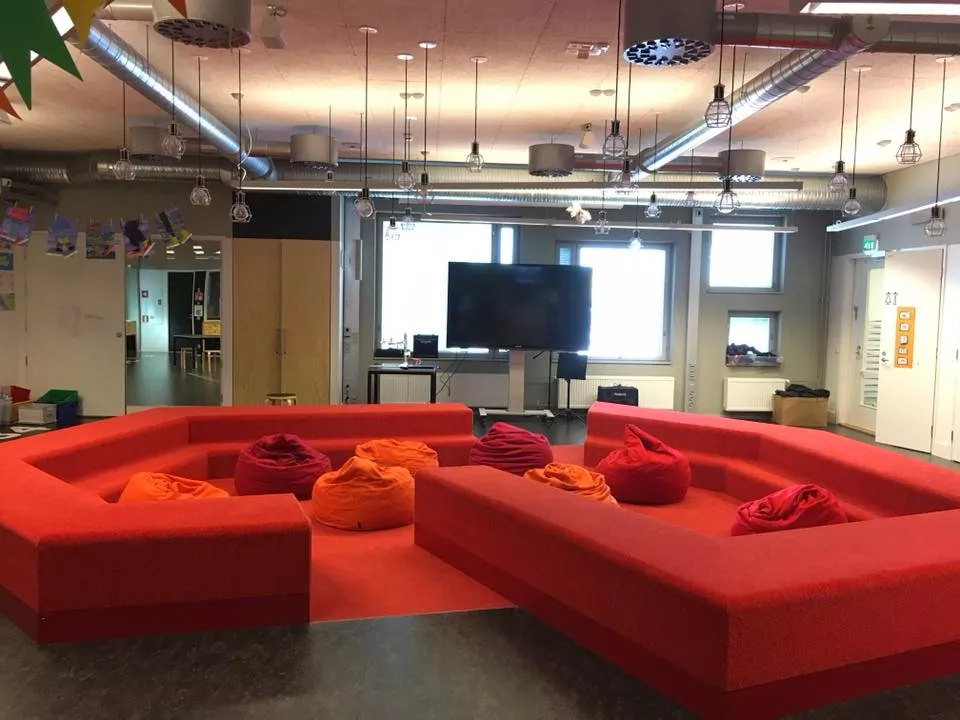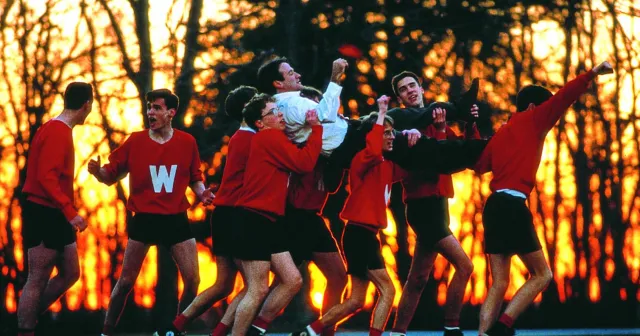My visit to two primary schools in Helsinki, Finland.
As a newly appointed Future Classroom Lead representative, I attended a meeting organised by the Future Classroom Lab co-ordinator Bart Verswijvel. The Future Classroom Lab network (http://fcl.eun.org/), set up six years ago, is coordinated by the European Schoolnet and meets twice yearly. This was the first meeting for 2018 and it took place in Helsinki, Finland. The objective of this meeting was to demonstrate what has been achieved up to the present day in each country and to discuss future initiatives. Yet, the highlight of the two-day meeting was the visit to two primary schools situated just a few stops by metro from our meeting place which took place in the EDUFI (Finnish National Agency for Education) building.
Lauttasaari Primary School (https://innovarch.fi/fi/projektit/lauttasaaren-koulun-avoin-oppimisymparisto/) was the first school we visited. The methodology used at the school corresponds to the new curriculum adopted by the Finnish Educational System 2 years ago which requires:
| 
|
This new school’s emphasis is on open spaces. Before the new school was built, a voluntary consultation process took place. Both teachers and pupils were consulted and workshops were held with both architects and designers.
The school comprises of large open spaces with mobile partitions on wheels (using lockers, shelving or curtains) and flexible furniture. All pupils have their own open locker for their personal belongings. There are also a few smaller classrooms which are the ‘traditional’ classrooms where the teacher can gather her pupils to deliver a short whole class explanation. All tables and chairs are mobile so that the tables can form different shapes used for group work. All chairs have wheels and all the furniture is colourful and made of wood. | 
|
Classrooms do not have Interactive Whiteboards (IWBs) but there are large monitors which are also on mobile stands. The school does not have a 1:1 mobile device policy but they have sets of small laptops which the teachers can pre-book for any digital related activities carried out with the pupils. Students are also allowed to bring their own device to school. All textbooks have their own corresponding programme which the children may use both at school and at home and apps or any online games are bought centrally.
The school adopts a system of co-teaching with teachers working in pairs. Every teacher has an average of 25 pupils and same grade teachers work together in large open classes. 1st and 2nd grade (7 to 9 year olds) teachers work collaboratively. Besides the class teachers, there are expert teachers such as language teachers, PE teachers and music teachers (all schools have very well-equipped music rooms). Pupils have their own class teacher but they move according to the time-table which is also very flexible – the teacher has the liberty to change it during the day.
For such a system to work, teachers require a lot of time for planning. It is demanded by the deputy (head of school) and it is part of their schedule. Teachers plan together in teams. It does not matter at what time they do the planning as long as it is done. This planning is done weekly and teachers decide when to do it. It is done when the pupils are at home. For example, in this school, team teachers meet twice a week for an hour. It was decided that they meet on Mondays from 8am – 9am before the pupils arrive and Fridays from 1pm – 2pm after the pupils leave. Every other week they have a team meeting with the assistant deputy to discuss progress.
Kalasatamas Primary School (https://www.facebook.com/Kalasatamaschool ) was the second school we visited.

We were met by the school deputy who showed us a presentation about the new school which is still being built. They only have from kinder to Grade 3.
| Every place in this new school is considered as a learning environment. Everything is an opportunity to learn. All electrical and air-condition ducts are exposed everywhere. Even the electrical room has a large window so that children can see what there is inside. Large windows are everywhere and there is an array of colours across the whole school. | 
|
Pupils have a free meal every day in the school cafeteria and teachers may join them (teachers are expected to pay for the meal). During the lunch break the teacher is required to sit with the children and impart table manners and other interesting information to the pupils.
The structure of this school is slightly different than the first one. There are large rooms with Greek theatre style seating in the middle leading to smaller rooms which are dedicated to other activities such as craft, art, and music.

In every school there is a psychologist, a nurse, and a social worker who work as a team. Every week the team meets the school’s SMT and every month all the school staff have a staff meeting to discuss any difficulties being faced by the educators and how the Senior Management Team (SMT) can support their staff to overcome the challenges.
The experience of the visits to these school has been very enriching for me as an educator. Experiencing the student-centred approach methodology in practice across the whole school was inspiring and stimulating. As a Head of Department in Digital Literacy, I look forward to disseminate such an innovative learning methodology to as many stakeholders in education as possible especially School Leaders. I shall definitely be sharing this experience with my fellow colleagues at the Directorate of Digital Literacy and Transversal Skills to further propagate this concept in as many schools as possible.
Having a Future Classroom in each of our local schools equipped with resources, furniture and equipment to nurture and foster more student-centred learning is a dream which although still rather distant is not impossible to achieve.
Antonella Giles
Head of Department Digital Literacy
Directorate of Digital Literacy and Transversal Skills.
Comments
Everything is an opportunity to learn.
Thank you for sharing your experience about the primary schools you visited in Finland! It was both inspiring and insightful.
I am an English teacher at a primary school in Latvia. While teaching comes with its fair share of challenges, I always strive to maintain a positive perspective.
Your blog entry left me feeling optimistic about the progress education is making and the milestones it has already achieved. Finland’s stable and forward-thinking education system serves as a powerful source of inspiration, offering valuable ideas that can be adapted to enrich our own communities.
As I reviewed the methodologies you described, I was pleased to find that some are already integrated into my school’s approach.
I would love to try co-teaching in my school. With classes of 24 pupils who have diverse abilities and behaviours, maintaining a dynamic, inclusive, and positive environment can be quite challenging.
Reading about experiences in other schools is beneficial and relatable. It reinforces the importance of shared learning within the global teaching community.
NSS Bulgaria
Още един блог за финландските измерения на образованието.
Чудесно попадение за популяризиране на съдържание, публикувано през годините в онлайн хранилището на EPALE.
Важен принос към насърчаване на професионалистите в сектора за учене на възрастни, за да се развиват чрез безплатните публикации, осигурени от Националното звено за подкрепа на EPALE.
NSS Bulgaria насърчава диалога между професионалистите
Скъпи колеги,
Споделете Вашето мнение с коментар под публикацията тук. Всяка Ваша гледна тока има неоценима стойност към развитието на общността на EPALE в България.
Очакваме Вашите коментари.





Somijas pieeja izglītībai
Rakstā aprakstītā pieredze Helsinku sākumskolās atklāj Somijas izglītības sistēmas veiksmes pamatprincipus – līdzsvaru starp mācībām un skolēnu labsajūtu. Uzsvars uz brīvību, sadarbību un radošumu īpaši sasaucas ar Valdorfa izglītības pieeju, kurā arī tiek akcentēta holistiska attīstība un individualitātes respektēšana.
Manā darbā Valdorfa skolā esmu novērojusi, ka līdzīgas metodes, piemēram, darbs projektos, praktiskie uzdevumi un cieša saikne ar dabas ritmiem, palīdz veicināt skolēnu motivāciju un dzīvesprieku. Arī Somijas piemērs, piemēram, radošuma un pašvadītas mācīšanās veicināšana, var kalpot par iedvesmu Valdorfa skolu praksē.
Tātad, Somijas izglītības sistēma parāda, cik svarīgi ir piešķirt skolēniem autonomiju un veidot vidi, kurā viņi jūtas iekļauti un atbalstīti. Šāda pieeja ir vērtīgs paraugs, ko var saskaņot ar Valdorfa pedagoģijas principiem, lai sniegtu bērniem dziļāku un līdzsvarotāku mācīšanās pieredzi, ko īstenībā jau pēdējus 10 gadus Eiropā izmanto Valdorfa sākumskolas ietvaros.